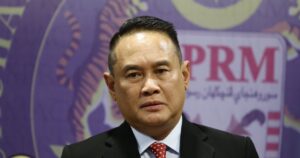KUALA LUMPUR: Malaysia’s approved investment performance in the first half of 2025 has sparked optimism about surpassing last year’s record, economists said.
With RM190.3 billion in approved investments secured in the first half of 2025, Malaysia is already past the halfway mark toward last year’s record-breaking RM378.5 billion.
Malaysian Investment Development Authority (Mida) said a total of 3,011 projects across the manufacturing, services and primary sectors are expected to generate 89,294 new jobs.
The agency said foreign investment surged 43.5 per cent, propelled by strong growth in all three sectors.
Services sector soared 100.7 per cent, while manufacturing and primary jumped 12.1 per cent and 57.4 per cent respectively.
The services sector led with RM118.6 billion in approved investments across 2,476 projects, up 25.6 per cent, comprising RM66.6 billion (56.2 per cent) from domestic sources and RM52 billion (43.8 per cent) from foreign investors.
The manufacturing sector followed with RM68.4 billion across 518 projects, driven mainly by foreign investments of RM53.3 billion (78 per cent) and RM15.1 billion (22 per cent) from domestic sources.
Meanwhile, the primary sector attracted RM3.3 billion in 17 projects, with domestic investments contributing RM1.8 billion (54.2 per cent) and foreign RM1.5 billion (45.8 per cent).
Singapore emerged as the leading source country with RM43.4 billion, followed by China (RM23.4 billion), United States (RM10.4 billion), British Virgin Islands (RM6.6 billion) and Italy (RM3.3 billion).
By state, Johor recorded the highest value of approved investments (RM56 billion), followed by Selangor (RM34.7 billion), Kuala Lumpur (RM30.1 billion), Pulau Pinang (RM18.9 billion) and Sabah (RM11.4 billion).
MOMENTUM CRUCIAL AMID GLOBAL UNCERTAINTY
Economists said sustaining the momentum through the rest of the year will hinge on converting pipeline projects into firm commitments amid a volatile global environment.
Dr Mohamad Idham Md Razak said investment approvals, particularly for large-scale projects, are seldom evenly distributed across quarters and can be subject to significant volatility based on a handful of mega-deals.
“The crucial factor will be whether the pipeline of prospective investors, cultivated by agencies like Mida and Investment, Trade and Industry Ministry, continues to materialise into firm commitments at a similar or accelerated pace, amidst a potentially fluid global economic landscape,” he told Business Times.
Idham said Malaysia’s investment outlook will be shaped by the direction of global interest rates and economic conditions in major foreign direct investment (FDI) source countries, as well as domestic readiness to leverage supply chain diversification trends.
“Concurrently, the escalating geopolitical fragmentation and the ongoing pursuit of supply chain resilience (friend-shoring or China+1 strategies) present a significant domestic opportunity for Malaysia to position itself as a stable, neutral and competitive manufacturing hub.
“Domestically, the greatest impacts will stem from the clarity and consistency of government policy, including fiscal incentives under national initiatives like the New Industrial Master Plan 2030 and the National Energy Transition Roadmap.
“Equally important is the perpetual imperative of maintaining a skilled and readily trainable workforce to meet investor requirements,” said the Universiti Teknologi Mara Business Management Faculty senior lecturer.
Economist Doris Liew, who specialises in Southeast Asian development, said Malaysia’s investment momentum is buoyed by optimism over the Johor–Singapore Special Economic Zone.
This is further reinforced by major policy initiatives such as the NIMP 2030 and the National Semiconductor Strategy.
She added that the forthcoming National AI Action Plan is expected to sharpen this edge, especially in the digital economy, where artificial intelligence (AI)-driven demand is set to supercharge investment flows.
“The AI boom will inevitably intensify demand for semiconductor chips and the country’s robust outsourced semiconductor assembly and test (OSAT) segment and data centre will see increased demand.
“However, this opportunity is tempered by global headwinds. The US tariff regime and the ongoing semiconductor battle between Washington and Beijing pose real risks.
“Questions about chips being rerouted to China, compounded by a past event of Nvidia chip leakages from Singapore via Malaysia, raise doubts among US firms about institutional safeguards,” she said.
Liew said that while 13th Malaysia Plan underscores a renewed push on TVET and upskilling, the NSS ambition to produce 60,000 engineers remains unmet, hampered by both institutional shortcomings in training providers and weak enrollment demand.
Sunway University economics professor Dr Yeah Kim Leng said ongoing uncertainties over Trump‘s tariff policies have led multinational companies, including US-based ones, to pause and reassess their investment decisions.
He said Trump‘s weaponisation of tariffs is aimed at reshoring manufacturing industries and jobs, reducing imports and increasing investments in the US.
Consequently, global investment decisions have been upended as the different tariffs secured by trading partners including Malaysia will result in changes to global production patterns and supply chain reconfigurations in the long term.
“Malaysia has also received record investments from global tech companies from the US, China and Europe and this inward FDI particularly for establishment of data centres is expected to slow down in the second half of this year,” he said.
FROM PLEDGES TO REAL PROGRESS
While approved investments are headline-grabbing, the real test lies in whether they translate into actual inflows.
Idham said to gauge the materialisation of these approved projects into real capital inflows, one must monitor building and construction permits, capital goods imports and quarterly gross fixed capital formation (GFCF) as key indicators of progress.
“Tracking the quarterly GFCF within the gross domestic product reports will show aggregate investment activity, while high-frequency indicators, such as electricity consumption from the industrial sector and cement sales, can provide timely proxies for on-the-ground operational progress,” he said.
Idham added that to ensure the nearly 90,000 new jobs are future-ready, Malaysia must enact a synergistic strategy between policy intervention and industry collaboration.
He said this necessitates a rigorous skills gap analysis, conducted in partnership with industry leaders, to precisely define the competencies required in digital, green and high-tech fields.
The findings must then directly inform the national curriculum, through enhanced science, technology, engineering and mathematics education and specialised programmes at technical and vocational education and training (TVET) institutions, while also enabling extensive upskilling and reskilling initiatives for the existing workforce.
“Finally, this effort must be underpinned by attractive career pathways and competitive remuneration structures to not only produce but, crucially, to retain this high-value talent within Malaysia, ensuring the nation reaps the full economic benefits of these investments,” he said.
Yeah noted that jobs are designated as future-ready at the approval stage, as only those in digital, green, high-tech, and other high-value sectors qualify—excluding low-skill, labor-intensive roles.
“To further prepare the Malaysian workforce, the government could offer targeted incentives for on-the-job training and upskilling, working closely with industry players to address skills gaps and mismatches,” he added.
© New Straits Times Press (M) Bhd






